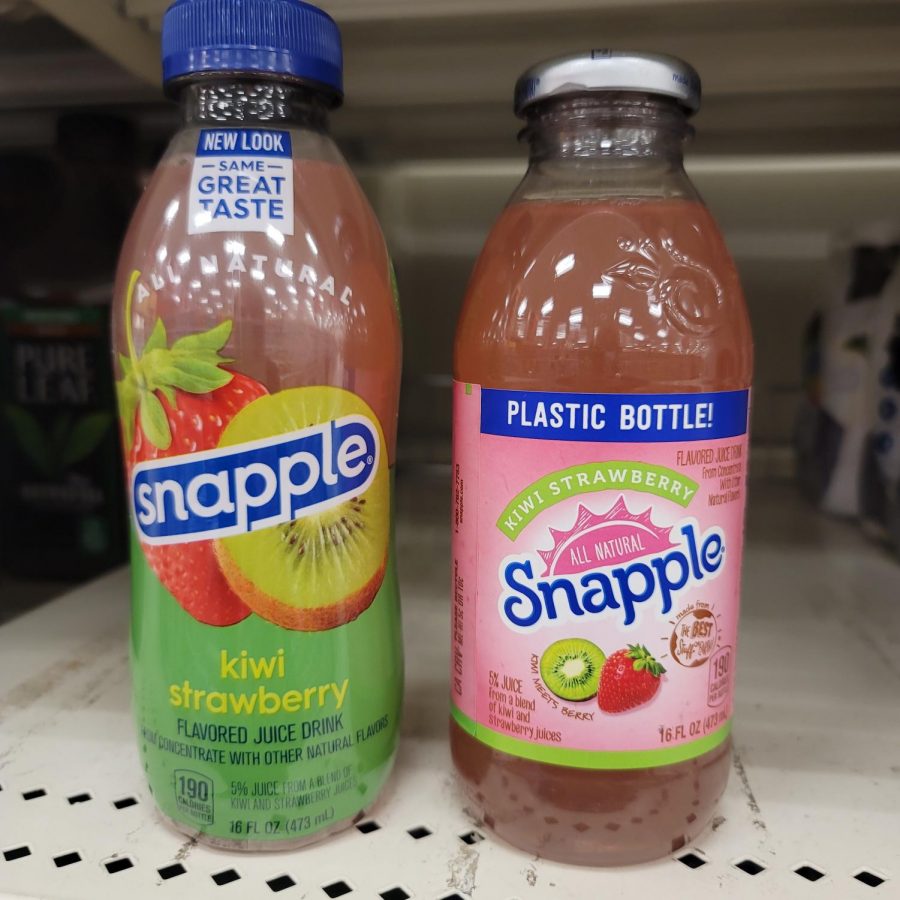Opinion: The new Snapple bottle is better for the environment, but it hurts my eyes
The new Snapple bottle (left) uses less plastic and has been redesigned
February 26, 2021
I am sure many of us are familiar with the sacred nectar that comes from the iconic Snapple bottle. I myself am a fan of the kiwi strawberry flavor.
Snapple has always had the slogan “made from the best stuff on Earth,” priding themselves in making (more) natural fruity beverages than their competitors and having a more conscious view towards the environment. They stuck by this for a long time, even removing high fructose corn syrup from drinks when they educated on some of the risks, and replaced it with natural sugar.
The problem is, in late 2017, Snapple abandoned their classic, hefty, reusable glass bottles in favor of a polyethylene terephthalate (PET) one that was nearly four times lighter and required nearly four times less energy to produce than the comparable glass bottle.
Like many, I was sad to see the glass bottle go, but I got used to it, because in reality, the bottle still looked the same, still felt the same, and was nearly the same experience.
People were quick to point out that this could not possibly be better for the environment than glass bottles like Snapple claimed, and technically was not. But in reality, very few of those glass bottles actually ended up being acquired by Snapple and reused. Many had to be remanufactured, thus using an insane amount of resources. In the end , it was not only more economical, but more environmentally friendly to produce the PET bottles.
Needless to say, I could live with the Snapple packaging change back in early 2018, but just recently, Snapple decided to completely overhaul their packaging again.
The new packaging, which bears little resemblance to the original packaging, boasts a new, contoured bottle with a redesigned label, and ditches the classic metal pop lid for the more common Gatorade-esque plastic lid.
I was not, and still am not a fan of the new appearance. The somewhat outdated looking label on the regular Snapple bottles was kind of fitting for a beverage that reached its peak popularity back in the 1980s and 90s.
In a light-hearted Instagram post, I mentioned my disapproval of the new packaging and tagged Snapple. To my surprise, they actually responded (albeit with some delightfully corporate language). After reading what they had to say, and doing some further research on my own however, I now understand their decision a bit better.
The goal of the change is not a bad idea. The bottles themselves are now made of 100% recycled plastic which Snapple and the Association of Plastic Recyclers claims uses 75% less energy and 80% less material to produce. Snapple claims that all these changes save energy in manufacturing and transportation, since they can move more beverages at once, as well as help create a demand for reclaimed plastic, which keeps it out of landfills and ecosystems.
After being bought out by the Keurig Dr. Pepper group in 2009, Snapple has likely adopted a more corporate mindset, and less of their “Earth-focused” practices have stuck around. Of course, as a for-profit company, the unfortunate truth is that Snapple and their parent group are in the interest of making money, not saving the environment. So in reality, they make most of their changes based on saving shipping costs, but that’s not to say the positive environmental aspects don’t mean anything.
After going through it a bit more, I truly can understand Snapple and the Keurig Dr. Pepper group’s decision to go for a more environmentally friendly bottle; it’s better for the planet (theoretically), and is in line with the Snapple brand. I believe that the changes made in the last couple of years and right now are likely a happy accident where corporate interests meet eco-friendly ones, and they can share a common goal.
Still, the old Snapple branding will be missed, especially those classic glass bottles that go way back to 1972, but it’s probably for the better. Besides, maybe some of the blame is ours. If we had all done a better job of properly recycling those glass bottles, maybe this change never would have happened.
I’ll be sure to recycle all my Snapple bottles from now on, even if they aren’t my favorite. And when I do, it will be in loving memory of the Snapple that used to be.









Bill • Sep 15, 2023 at 2:53 pm
In my experience whenever a company changes labels on whatever they always and always make the product cheaper I did purchase a large bottle of Snapple peach flavor, it was like sour water with a caramel color I will never buy it again, yes perhaps the glass cost more to manufacture but that was a classic appeal for a Snapple product with a premium taste, you have ruined a good product plastic leach into the drink and goes into your body, yes you save money but you’re destroying peoples health, even the store manager I spoke to said he did not like the taste of Snapple‘s Now!!!
Joe • Jul 26, 2022 at 9:29 am
You couldn’t be more wrong… glass is far better for the environment, and for human’s to consume from, than plastic is.
tommy • Jun 21, 2022 at 5:26 pm
i openened it and blood came out should i be scared
Charlie • Feb 1, 2022 at 1:15 pm
The new bottle is 100% recyclable. Why isn’t there a Recycling number inside the recycle “triangle”? Read the fine print.
It still tastes good.
Donna W. • Apr 11, 2022 at 6:19 pm
I couldn’t disagree more. I was probably one one of the biggest diet peach fans. In fact my name became grandma peaches. I LOVED it for almost 50 years but not anymore. It burns my mouth and gives me headaches not to mention the taste. No more Snapple for me.
Evelyn A Myers • Nov 2, 2021 at 1:02 pm
Are you being paid by Snapple? Get real! Plastic is NOT better for the environment. Your twisting of the true harm to the environment is disappointing. Plastic is suffocating the planet and the corporations bottom line ALWAYS trumps what’s best for everyone and the planet.
CJ • Oct 24, 2021 at 11:51 am
My loved this tea until they went to the plastic bottle. Now the flavors are no longer there. Plastic makes everything taste plasticy. Unfortunately for Snapple, we will no longer be buying.
Dianne Cook • Aug 30, 2021 at 3:19 pm
When the plastic bottles came out , i thought let’s give it a try. Unfortunately, the peach snapple tastes terrible. I couldn’t even drink it. I have looked for glass bottles but can’t find any. I guess I will have to look for another non-carbonated drink.
Michael Marcus D Marcus • Aug 20, 2021 at 11:28 am
Snapple in plastic tastes different and not in a positive way. I don’t know whether it is the feel of the plastic on my lips or that the plastic actually changes the taste of the drink. It doesn’t matter why. It has changed and I don’t like it. I loved Snapple in the glass but won’t be buying anymore Snapple.
Gary Dozier • Aug 16, 2021 at 8:57 am
Fourteen years ago I was diagnosed with esophageal cancer and ultimately had my esophagus removed. I quickly acquired a taste for the best non-carbonated tea drink, Snapple…raspberry tea. Ahh, but after nearly a decade and a half of buying up every available 12-pack, I have now closed the door on Snapple for good! The plastic has leached into the Snapple, making it unacceptable to drink. I am certain that Snapple will ne’er return to glass, so I am actively sampling alternatives. Arrivederci, Snapple!
Bob • Aug 5, 2021 at 1:58 pm
We use Snapple’s diet lemon tea. The new 2021 redesigned plastic bottle may be easier to hold, but no, the taste is different. I don’t know if they’ve changed the formula, or it’s got something to do with a slight difference in holding temperature between the glass vs the plastic. And despite their 2018 tweets to the contrary, NO, these new 16 oz bottles have no “facts” under their white plastic lids. Not a happy consumer family about this.
Kim • Jul 25, 2021 at 4:22 am
The new Snapple bottles are horrible. Every time I take a drink it runs put of the corners of my mouth, down my chin, then onto my shirt. I think it’s the way it’s designed. My peach tea just doesn’t taste the same either. Not to mention you can barely read the fun fact on the lid due to the color of the lid. I prefer drinking this than other teas cause it’s tastier, so I probably won’t stop buying it. However, they need to rethink this change.
Lois M. Torok • Jul 8, 2021 at 8:27 am
We have been drinking Snapple forever! Love the lemon tea ?. Always recycled the bottles and lids. Actually rinsed out before placing them in the special container.
The “new” Snapple does not taste the same! I have stopped buying it. Not alone. Even on sale, I have noticed that other people are not buying this new product. The shelves in stores are full. Very unusual especially during the current summer months. A shame. Why ruin a good thing? Plastic is SO bad for the environment!
Please rethink this decision. Very disappointing!
David Jacobs • Jul 5, 2021 at 4:54 pm
I loved the glass bottles, but understand that the plastic is the smart way to go. What I don’t like is the little label that says “NEW LOOK – SAME- GREAT TASTE.”
I found that to be totally false. In fact, I have had 6 friends and family tell me that the taste is not even close! It’s better than drinking colas, but that is it. The taste is not where it should be!
Briana • Jun 14, 2021 at 12:30 pm
Not being able to pop the lid open makes me never want to buy Snapple again.
Joe Castellucci • May 27, 2021 at 8:42 pm
Horrible new bottle. I don’t know if it’s just me but the bottle has an uncomfortable feel at the corners of my mouth. Because of that poor feeling a couple of drops of the product drizzle down the side of my face. What happened to that cult following that Snapple developed over the years to smack the bottom of the bottle with the palm of your hand and hears that “Snapple “ pop. Gone. Like I’m gone from Snapple. The dribbling down my face is the real reason I’m not going to buy any longer. Am I the only one this happens to?
Tyandrah Ashley • Apr 9, 2021 at 8:33 pm
I like this article! It covers all the basics for the rebranding and new packaging design for Snapple.